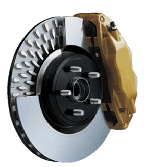Brake Questions Answered by the editors of BRAKE & FRONT END
1. What causes runout?
Brake Rotor runout can be caused by several things: variations in manufacturing tolerances, sloppy resurfacing procedures, a buildup of rust and corrosion between the rotor, hub and wheel, and uneven torque on the lug nuts.
 2. What else can cause brake pulsation problems besides the rotors?
2. What else can cause brake pulsation problems besides the rotors?
Loose wheel bearings will cause the rotor to tilt in the caliper when a load or side thrust is placed on the bearings. Disc brake pistons require lots of fluid volume and pressure to push the pad against the rotor. If loosely adjusted wheel bearings force the pistons into the caliper, the result will be a low or spongy brake pedal.
3. What exactly is “pulsation” and how does it relate to “warping?”
If a vehicle equipped with floating or sliding calipers has a slider problem which prevents the caliper housing from moving, runout can cause pulsation. The caliper piston will move in and out as the rotor rotates resulting in fluid movement and pedal pulsation. Likewise, fixed caliper vehicles are sensitive to runout induced pedal pulsations. Fixed calipers have pistons on both sides of the rotor due to the stationary caliper housing. Excessive runout will cause piston movement and can result in pedal pulsation due to the runout.
4. What else can cause customers to think their rotors are warped?
Brake roughness is the other component to the equation and it is often misinterpreted and misdiagnosed problem. At the root of brake roughness is a characteristic called Brake Torque Variation (BTV). This can be determined by measuring torque multiple times within one wheel revolution. The brake torque variation is the maximum torque measured within one revolution subtracting the minimum measured.
If BTV is excessive, the vehicle will start to transmit the BTV back to the driver and generate a comeback. The symptoms are pulsation in the pedal.
5. What is Disc Thickness Variation?
People generally equate a high runout value with “warping.” In reality, runout by itself is not a direct or sole generator of pulsation. The characteristic that most directly generates roughness is actually Disc Thickness Variation (DTV). This measurement is the result of measuring the thickness of the rotor surface at multiple spots around the rotor.
The DTV is the largest (thickest spot) minus the smallest (thinnest spot) of the rotor. This action of thick and thin spots passing through the caliper generates the brake torque variation. When the thick part of the rotor is forcing itself through the caliper, the torque of the brake and the pressure in the caliper rise. When the thin spot passes through, the torque drops and pressure drops. Very small amounts of DTV can create a significant problem. Today, new vehicles are typically built with a thickness variation of less than 0.00078”. Thickness variations in excess of 15 microns (0.00059”) can easily generate driver complaints.
6. “Do I have to measure the runout for every brake job? I don’t have the time!”
The bigger question is, “Do you have time for comebacks?” A dial gauge is used to measure runout in the rotor and hub assembly.
The dial gauge is a very robust piece of equipment that can last a lifetime. It is also a good idea to invest in a good magnetic base or vise-grip handle that can be setup quickly.
Always use a dial indicator to verify the amount of runout present in a rotor and hub assembly, both before and after the rotors have been machined. This must be performed even if you are using an on-the-car lathe. By measuring the rotor on the hub, you can also check for play in the wheel bearings, corrosion on the mounting surface and other possible errors. Even if you are putting new rotors on a vehicle, runout should be checked. It doesn’t take much, only about .002 inches on some vehicles, to cause a noticeable pulsation. Also, if you are using a bench lathe, the dial indicator can be used to check to see if you have mounted the rotor or drum properly to the lathe.
7. I drove the vehicle after the brake repair and there was no pulsation problem. What caused the customer to comeback after a few thousand miles with a pulsation problem? Is their braking technique at fault?
Ninety-eight percent of the time, pulsation complaints are not the fault of the driver. The cause of the DTV/Runout and resulting pulsation is a product of the interaction of the rotor and pads over time and how the caliper interprets the runout. But, the main reason why the customer is back is that the runout was not measured in the hub.
The vehicles most susceptible to reoccurring pulsation are those that use unitized bearings. Unitized bearings are preloaded and have zero play. No wheel bearing play results in the runout being “seen” by the brake pads with every revolution of the rotor. The resulting high and low spots scrape the brake pads with every revolution of the rotor. This scraping occurs during not only during braking, but also non-braking.
The long-term result of this scraping is the DTV. Pedal pulsation is the symptom of excessive DTV. The alternating thick and thin spots of the rotor cause the caliper piston to move in and out as the brakes are applied. The caliper piston moves out on the thin spots and in on the thin spots. The piston movement causes brake fluid to move in the hydraulic system and results in corresponding brake pedal movement in the form of a high-speed pedal pulsation.
8. There is not any runout in the rotor, but the customer is still complaining of a pulsation problem. What could it be the cause?
The problem might not be the brake rotors, but the pads. If the brake system is used to the intended limits and the brake pads go beyond their operational temperature limit they will deposit brake pad material unevenly on the brake rotor. Pad material build up creates uneven rotor thickness, which gives you the sensation of a “warped” brake rotor.
Try switching to a more robust brake pad, and clean up the rotors with a light pass on the lathe.
9. Volcanic Bearings?
Many bearings will actually have a machined step in the region the wheel studs are installed. This masks the localized “volcanoing” that occurs in the material around the stud. This micron (1 micron = .000039”) level volcanoing will distort the rotor when the clamp load of the wheel is applied.
10. Will a non-directional finish reduce the chance of a comeback for pulsation problem?
In theory, a non-directional finish will help to burnish the brake pads more effectively. For some friction materials, the non-directional finish will help to deposit a thin layer of friction material on the rotor’s surfaces.
| According to GM… In technical bulletin #00-05-22-002 to its dealers, GM says: |
“Brake rotors should only be turned when one of the following rotor surface conditions exist: severe scoring with depth in excess of 1.5 mm or 0.060 inch, pulsation from excessive lateral runout of more than .080 mm or .003 inch, thickness variation in excess of 0.025 mm or 0.001 inch, or excessive corrosion on rotor braking surfaces.”
Lug nut torque is also extremely important. Under-torquing only a single lug nut may create as much as 0.003-inch of lateral runout in a rotor!
.0015 inch or less of lateral runout is needed on the rotors to prevent pedal pulsation. If runout is excessive, try indexing the rotor on the hub to see if a change in position helps. Tapered steel shims are also available, or use an on-the-car lathe to cut the rotors in place.













